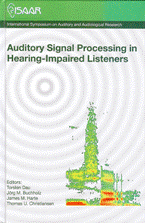The occlusion effect and its reduction
Abstract
The occlusion effect is a major problem for hearing aid wearers. If unsolved, it makes their own voice sound un-natural, and if solved it can severely limit the gain that can be achieved without feedback oscillation. It appears to be caused by the jaw vibrating to a much greater magnitude than the other bones of the skull, because of the much lower weight of the jaw. Jaw vibration then causes one wall of the ear canal to vibrate with respect to the opposing wall. A new solution to the occlusion effect is to add a second, inward-looking microphone to a hearing aid. This microphone senses the occlusion-induced sound pressure within the ear canal, inverts it, and feeds it back to the receiver to partially cancel the occlusion-induced sound pressure. The processing operates according to well-established rules of negative feedback, an important component of which is ltering to ensure that gain around the loop is less than unity for any frequency at which phase shifts cause the feedback to be positive. Occlusion reduction of 15 dB in the target frequency range is achievable, and as this is the same magnitude as the occlusion effect for the average hearing aid wearer, active occlusion reduction can completely remove occlusion for the average wearer, despite having little or no venting. Because the active occlusion reduction also cancels any sound entering the ear canal via any small vent or leakage path, the processing allows electronic ampli cation to be provided, even with negative gains if desired. This substantially widens the range of frequencies over which directional microphones and adaptive noise suppression can be effective.
References
Beranek, L. (1986). “Acoustics,” Revised edition, Am. Inst. of Physics.
Carle, R., Laugesen. S., and Nielsen, C. (2002). “Observations on the relations among occlusion effect, compliance, and vent size,” J. Am. Acad. Audiol. 13(1), 25-37.
Dillon, H., Birtles, G., and Lovegrove, R. (1999). “Measuring the outcomes of a national rehabilitation program: Normative data for client oriented scale of improvement (COSI) and the hearing aid user’s questionnaire (HAUQ),” J. Am. Acad. Audiol., 10, 67-79.
Dillon, H. (2001). “Hearing Aids,” Sydney, Boomerang Press.
Hakansson, B., Carlsson, P., and Tjellstron, A. (1986). “The mechanical point impedance of the human head, with and without skin penetration,” J. Acoust. Soc. Am., 80, 1065-1075.
Hitay, O. (1999). “Introduction to feedback control theory,” CRC Press, Inc.
Killion, M. C. (1988). “The “hollow voice” occlusion effect,” in Hearing Aid Fitting: Theoretical and Practical Views, 13th Danavox Symposium, Copenhagen, edited by J. Hartvig Jensen, 231-241.
MacKenzie, K., Browning, G. G., and McClymont, L. G. (1989). “Relationship between earmould venting, comfort and feedback,” Br. J. Audiol. 23(4), 335-337.
Mueller, H. G., Bright, K. E., and Northern, J. L. (1996). “Studies of the hearing aid occlusion effect,” Seminars in Hearing, 17(1), 21-32.
Pirzanski, C. Z. (1998). “Diminishing the occlusion effect: clinician/manufacturer-related factors,” Hearing J., 51(4), 66-78.
Slager, G. E. C. (1997). “Mathematical model of the human jaw system simulating static biting and movements after unloading,” J. Neurophysiol., 78(6), 3222-3233.
Additional Files
Published
How to Cite
Issue
Section
License
Authors who publish with this journal agree to the following terms:
a. Authors retain copyright* and grant the journal right of first publication with the work simultaneously licensed under a Creative Commons Attribution License that allows others to share the work with an acknowledgement of the work's authorship and initial publication in this journal.
b. Authors are able to enter into separate, additional contractual arrangements for the non-exclusive distribution of the journal's published version of the work (e.g., post it to an institutional repository or publish it in a book), with an acknowledgement of its initial publication in this journal.
c. Authors are permitted and encouraged to post their work online (e.g., in institutional repositories or on their website) prior to and during the submission process, as it can lead to productive exchanges, as well as earlier and greater citation of published work (See The Effect of Open Access).
*From the 2017 issue onward. The Danavox Jubilee Foundation owns the copyright of all articles published in the 1969-2015 issues. However, authors are still allowed to share the work with an acknowledgement of the work's authorship and initial publication in this journal.


